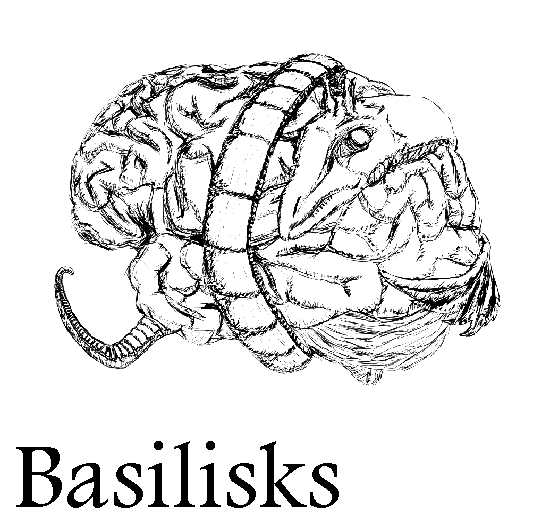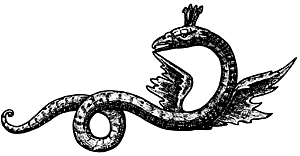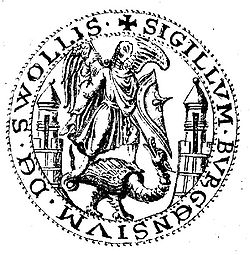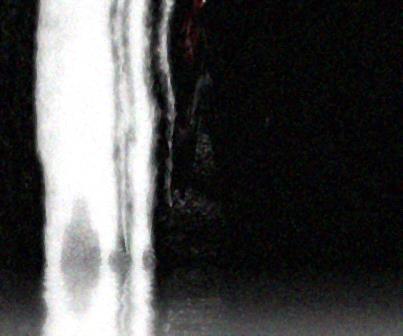Basilisks
Basilisks are a type of demon that can only interact with the physical world through creative expression, said to kill or torment anyone that understands them.

Basilisks in modern occultism refer to a type of demon who are sealed away from God's creation and therefore spread through the creations of humans, tormenting those that perceive the work. They are the direct inspiration behind the idea of memetic hazards in horror and science fiction, as well as inspiring several philosophical concepts.

The myth of the basilisk was created in the first century, originally as a very real consequence of the mating of a cockerel and a serpent. The inverse form of the basilisk was called a cockatrice. They were said to have such potent venom that any animal or human that dare look in its direction would be immediately cast down in death. The only weakness of the basilisk was the weasel, whose musk and ferocity would drive out the basilisk from its den and kill it. Their name originates from the Greek words for "Little King," as they supposedly had a growth on their heads resembling a crown.

Similar accounts of basilisks persisted for years, though shifting attitudes of religion in the Roman Empire during the fourth century lead to their association with Christian mythology, particularly due to the notion of being serpent's spawn. Basilisks became demons sneaking into the material world through unnatural birth, using their terrifying ability to sabotage works of man and killing any who caught it in the act. It was from this that folk stories of angels descending to smite a vile basilisk that good men would otherwise fail to touch originate, similar to tales of knights slaying dragons. The iconography of the angel slaying the basilisk has become synonymous with many European regions over the years, as seen right.
This idea would begin to evolve over the years, particularly in occult writings behind closed doors. Initially, there was the idea that sigils tied to demons that became basilisks would inherit their deathly properties and was to be used as a very dangerous weapon. It was of great frustration that creating such sigils was nigh-impossible without clairvoyance, as it had to represent a tragedy associated with the basilisk. Obviously, you can't really know a basilisk caused any specific tragedy without suffering its effect.
Many scholars misunderstood the notion of tragedies associated with basilisk mischief, causing their mythology to change so that basilisks were born from the negative energy of traumatic events. The physical manifestations were merely subjective, akin to normal demon hauntings. The real basilisk was in the sigil itself, and once made could recreate itself inside the summoner's mind or elsewhere should it be given a medium. This made creating one fairly easy should iconography of a tragedy be understood, but also utterly and deeply taboo. Given the roots of the entities, it was believed that the most powerful basilisks would come from the end of days and sin of creation respectively, both invoking notions of The Beast. Because Eden is forbidden and no man can know the hour, it's said that a basilisk sigil from these would be impossible to create willfully. One basilisk sigil from a tragedy related to The Beast is claimed to exist, though what event it represents is deliberately left vague.

That lead to the modern basilisk we love today, though its influence extends beyond itself. With the rise of occult influence and the trope of forbidden knowledge in 20th century horror, the idea of basilisks became more common in the public zeitgeist. As the idea of memes as a concept became popular, the philosophy combined with the pre-existing horror to create the idea of memetic hazards and cognitohazards. The effect metatextually in the works that incorporated it is strange and eerie, as it leaves the audience wondering if perhaps in all the effort to create the work a real hazard slipped in. The fear that just by telling your friend about a book you read, or a film you watched, you could be invoking unknown paranormal harm. The concept has enjoyed even more relevancy recently given the release of films like The Ring. On-line, niche communities discuss memetic hazards in rapt attention. You can read just about any /x/ creepy pasta or one of those "SCP Foundation" posts from the past year and see the influence.
Below is an example of a modern "cognitohazard" image, which usually consist of strange and surreal visuals, or just as likely some red face with a shitty story attached.

Last Edited by Webmaster A. on October 12, 2008.
(C) 2002-2008
